
Topics
Guests
- Beverly Allamlives five miles from Moore, the Oklahoma City suburb destroyed by the tornado. She witnessed the tornado from a distance. Her family lost everything in the May 1999 tornado in Oklahoma. The recent tornado ripped right through her old neighborhood.
- Jeff Mastersdirector of meteorology at the Weather Underground.
Links
Dozens have been killed and more than 200 wounded in a devastating tornado in Oklahoma. The storm tore through the Oklahoma City suburb of Moore, leveling two elementary schools, a hospital and scores of homes destroyed. Rescue crews continue to dig through the rubble in a bid to find survivors. It was the deadliest tornado to hit the United States since 161 people were killed in Joplin, Missouri, two years ago. We’re joined by two guests: Beverly Allam, an Oklahoma resident who lives a few miles from Moore and lost everything in the state’s tornado in May 1999, and Jeff Masters, director of meteorology at the Weather Underground.
Transcript
AMY GOODMAN: We begin today’s show in Oklahoma, where at least 91 people, including 20 children, are feared dead after a massive tornado tore though the Oklahoma City suburb of Moore. The storm leveled two elementary schools, a hospital and hundreds of homes. The Oklahoma medical examiner has already confirmed 51 dead and has been told by emergency services to expect 40 more bodies found in the debris. Area hospitals said at least 60 of the 240 people injured were children.
Some of the first footage of the devastation was captured by a news helicopter operated by the TV station KFOR.
JON WELSH: If you guys can see this, I don’t know how to explain it, how to describe it. This is—this is terrible. This is war-zone terrible. This school is completely gone. If you guys are still with me here, this damage path is right there on the top right of your screen. There’s the school. I’m un-for-sure the exact name of it, but that’s—that’s going to be on—it’s going to be south of—south of Fourth Street, it’s going to be east of Santa Fe. Whatever school that is, it’s going to be—it is, like you see, completely destroyed, as kids run up to hopefully their loved ones. But this whole area right here, guys, is—it’s completely destroyed. The houses are destroyed.
AMY GOODMAN: The storm was so powerful, it was able to unlatch cellar doors where residents had taken refuge. This is tornado survivor Ricky Stover.
RICKY STOVER: We thought we died, because we were inside the cellar door, we locked the cellar door once we saw it coming, it got louder, and next thing you know, you see the latch coming undone, and we couldn’t reach for it, and it ripped open the door. And just glass and debris started slamming on us. And we thought something—we thought we were dead, to be honest.
AMY GOODMAN: Witnesses reported Monday’s tornado appeared stronger than the massive twister that tore up the region May 3rd, 1999, killing more than 40 people and destroying thousands of homes. The 1999 tornado was ranked EF5 and had highest winds ever recorded on Earth.
The Federal Emergency Management Agency has already begun helping local residents. Oklahoma is home to two of the Senate’s most vocal critics of FEMA, Republicans Jim Inhofe and Tom Coburn. They have both opposed increased funding for FEMA over the years and backed a plan to slash disaster relief to victims of Hurricane Sandy. Coburn is already insisting any federal disaster aid be paid for with cuts elsewhere.
To find out more about the effects of Monday’s tornado, we’re joined now on the phone by Beverly Allam, who lives five miles from Moore, the Oklahoma City suburb destroyed by the tornado. She witnessed the storm from a distance. Her family lost everything in the May ’99 tornado. The recent tornado ripped right through her old neighborhood.
We’re also joined via Democracy Now! video stream by Jeff Masters, director of meteorology at Weather Underground.
Beverly, let’s begin with you. What did you see?
BEVERLY ALLAM: Good morning. Well, this is just déjà vu. The unimaginable has happened to this area once again. It was just another unbelievable, huge darkness that just came over the land and just swept everything off in its path. There’s nothing that could have really survived this, unless you were underground or totally out of its way.
AMY GOODMAN: Can you explain what you saw yesterday? What time was it in the afternoon?
BEVERLY ALLAM: Well, this was around 2:30 p.m., and I had just left Moore. We had lunch there and had stopped at a tag agency right there and realized that the air quality, you know, was getting worse. And, you know, you could actually feel pressure changes, and you can see the dark clouds starting to come up. And, of course, the rain starts sprinkling. And then, this thing come up so fast, and no one could imagine that it would grow into what it did so quickly, that it just kept growing and growing and growing. And it just all happened so fast. And it’s just—the air just starts turning and twisting, and that’s just it, simply. You just have to get out of the way.
AMY GOODMAN: What kind of warning was there yesterday afternoon, Beverly?
BEVERLY ALLAM: Oh, we have great warning systems, and we have to give a lot of credit to all of our local stations. Of course, all the sirens blew for a long time, several—several different instances in all of our—all the communities around Norman and Moore, south Oklahoma City. All the sirens were going off, because you never know exactly which way these things will turn. So, we do have early warning, and it gave people a lot, a lot of time to really take their precautions needed.
AMY GOODMAN: And how did this compare to what you lived through, what, some 13 years ago?
BEVERLY ALLAM: Well, it’s just the same. The only thing I can say that’s really a lot worse this time is this is such a much more heavily populated area now. And it’s just the loss of lives of all these children at the school that weighs so heavily in all of our hearts at this time. For their families to recover, they’re going to need all of the grief counselors they can get and a lot of donations. And it’s just—you know, I equate the ground where Plaza Towers school was to Ground Zero in New York. And I don’t know if they’ll ever be able to rebuild on that school. This is considered hallowed ground now where all those children lost their souls. So there’s a lot to weigh on the minds of our civic leaders. And a lot of families just—the help they’ll need to get through this, I know that they’ll—they’ll be supplied with all the necessary tools.
AMY GOODMAN: As the storm swept north through central United States, a Kansas meteorologist stayed on the air as the tornado closed in on the studio. The cameras kept rolling. We’re going to go to a clip.
JD RUDD: Folks who are on KSN.com, who are no doubt watching us right now as this storm bears down on the city of Wichita, I—
DAVE FREEMAN: You know, JD, in 20 years I’ve never said this—
JD RUDD: Yeah.
DAVE FREEMAN: —but I think it’s our time to go.
JD RUDD: Dave. And—
DAVE FREEMAN: I really do. We’ve been monitoring the conditions here downtown. So, at this point, folks, those—we here at KSN are moving to our shelters. We are moving to our shelters. JD and I will continue to talk with you as long as we can. We’re leaving the radar image up, but it appears that it is time for all of us to get to shelter. Get to shelter right now. Ryan Newton!
UNIDENTIFIED: Ryan, get to the shelter now!
DAVE FREEMAN: Ryan Newton, now, Ryan!
UNIDENTIFIED: Now!
DAVE FREEMAN: Everybody, down below! Let’s go!
AMY GOODMAN: The station. Jeff Masters, director of meteorology at Weather Underground, if you could take it from there, if you could explain what happened, explain the tornado that struck Moore yesterday.
JEFF MASTERS: Yeah, the sound you heard in that video we were just looking at, that was the sound of large hail pounding on the roof of that TV station. And, boy, the weather gods have just unleashed a full gamut of bad weather for the Central Plains—I mean, high winds, large hail, flooding rains, and now these tornadoes. We’ve just seen the perfect sort of classic springtime tornado weather that you get several times per year in the central U.S., with very warm, moist air from the Gulf of Mexico coming to the north and meeting up with very cold, dry air from Canada, and then, on top of that, some dry air coming in from the Southwest U.S. kind of acting as a cap to some of the intense thunderstorms, allowing them to build up. And then, finally, when you get enough energy, that cap is broken, the updrafts go speeding up to the top of the atmosphere, and you get these supercell thunderstorms like we saw over the past two days and will again today over some portions of the Midwest.
AMY GOODMAN: Jeff Masters, why is this area of Oklahoma—why is it so vulnerable?
JEFF MASTERS: Yeah, poor Moore, Oklahoma. I mean, they’ve been hit by three EF4 or stronger tornadoes in the past 14 years, including the most intense tornado ever measured: 302 mile-per-hour winds in the 1999 storm. And I guess it’s just bad luck, because you would expect other areas, you know, should have gotten that kind of pummeling, you know, not so much concentrated in area like Moore. I mean, downtown Oklahoma City has never been hit as bad as Moore has been hit. And I don’t know how to describe, you know, what accounts for that bad luck. Maybe there is some sort of terrain effect we don’t understand that makes that area more vulnerable than, say, downtown Oklahoma City.
AMY GOODMAN: How does this tornado compare to the one right there, right nearby, in 1999?
JEFF MASTERS: Yeah, yesterday’s tornado was larger and covered a bigger area, maybe at least twice as large. As far as the top wind speeds go, we’re not really sure how strong the winds were in yesterday’s tornado. We’ve been given a preliminary rating of EF4, which means 166 to 200 mile-per-hour winds, by the National Weather Service, but they haven’t done detailed damage surveys yet, and it’s quite possible they’ll upgrade this to an EF5, which means winds in excess of 200 miles per hour, certainly very close to a top-end sort of tornado. They don’t get much stronger than this.
AMY GOODMAN: You think this could be the largest in history?
JEFF MASTERS: It will certainly rank up there in the top 10 or so, I think. And, you know, we don’t have a very long history. We go back to about the early 1950s as far as, you know, measuring how big these storms are. And we didn’t have radar until, oh, the 1990s, as far as being able to look on a Doppler radar how big these storms are. So, it’s certainly going to be one of the biggest in history. We don’t know, you know, if it’s going to actually be a record-breaker at this point yet.
AMY GOODMAN: Jeff, what is the connection? Is there a connection between this tornado and global warming?
JEFF MASTERS: That’s a tough call. I mean, it’s an important question. And we really have a huge area of unknowns here to try and answer that question. The big problem is the tornado database isn’t very good. It only goes back about 60 years. And we don’t measure tornadoes directly. They have to run over a building before we know how strong they are. So we’ve got a lousy database. And our computer models to study tornadoes aren’t very good yet. We don’t understand what makes them tick very well. So, even with our highest-quality, finest research models, can’t tell you what a tornado is going to do and how it’s going to form, we can’t expect our climate models to do that sort of math, either, because they’re a lot courser. They can’t look at the fine details very well. So, a lot of uncertainty about how climate change might affect tornadoes.
I might add that over the past 12 months, we’ve seen the record lowest number of tornadoes in U.S. history, at least the EF1 and stronger tornadoes. But back in 2011, we saw the record highest 12-month total of tornadoes. So, we’ve just been getting kind of weather whiplash with our tornado seasons. I mean, going from the extreme highest to the extreme lowest, that’s really tough to, you know, say what is the trend going to be. Well, it might be one or the other. And at this point, I can’t identify what climate change is likely to do, which of those type of years we’re more likely to get.
AMY GOODMAN: In 2011, after a series of large tornadoes, Kevin Trenberth, head of Climate Analysis Section of the National Center for Atmospheric Research, said, quote, “It is irresponsible not to mention climate change. … The environment in which all of these storms and the tornadoes are occurring has changed from human influences.” Your response to that, Jeff Masters?
JEFF MASTERS: That’s right. Every weather event is substantially changed now by climate change. There is more heat in the atmosphere. There is more moisture. And something I’ve been seeing the last three years is the jet stream patterns have been getting very extreme. I’ve never seen, in my 30 years as a meteorologist, the sort of unusual sorts of jet stream patterns where we get these large loops, where they tend to get stuck in place, contributing to extreme weather. Whether we’re going to be seeing more tornadoes because of that, I don’t really know, because when you do change a jet stream like that, you are actually going to slow the winds down of the jet stream. And when you have slower winds, you get less of a twisting motion to get tornadoes spinning. So, in theory, that should decrease tornadoes. But on the other hand, when you have a warmer atmosphere, the air is more unstable, and that’s the other key ingredient we need to make tornadoes. How those two factors are going to interplay in the future, we don’t know. But I think Dr. Trenberth is right: We have to look at the changed environment that all these sorts of weather systems are in now to look forward to what we’re going to see in coming decades.
AMY GOODMAN: I wanted to end with Beverly Allam. Oklahoma, your two senators are the most vocal critics of FEMA, the Federal Emergency Management Agency, Senators Inhofe and Coburn. They have both opposed increased funding for FEMA and backed a plan to slash disaster relief to victims of Hurricane Sandy, though the local congressmember voted for that relief for Hurricane Sandy, recognizing well that Oklahoma was in the path of these tornadoes. What do you think about this, Beverly?
BEVERLY ALLAM: Well, truly, I wish they would change their vote. Perhaps they don’t realize, maybe having not lived through it personally, the effects that it does have and the help that we really do need. The just sheer numbers of people displaced that need immediate homes is an incredible, increasing number, and they really need the help quickly. They can’t wait on legislation; they need it now. So they need something in place to take care of these in the more immediate situations.
AMY GOODMAN: Can you, finally, talk about these needs that you have—someone, you, Beverly, know well, given that you were completely wiped out in 1999 and, of course, live right near, were in Moore yesterday?
BEVERLY ALLAM: Well, that’s just it. You need to find immediate shelter. You have no home. You have no roof over your head. Unless you have a family in the area or a good friend that could help take you in, you’re sleeping out in your car. You have to have food, clothing. We had only the clothes on our backs, and most of the family had no shoes on, literally nothing. So you have to just start going to, you know, your thrift stores, local markets for the people. You have very little money at the time. All were poor students, you know, and so on. And so, it’s just a question of getting help from all the [inaudible]—
AMY GOODMAN: And the federal government, how did—
BEVERLY ALLAM: [inaudible] the federal government came in. They said they would give X amount of dollars. And then, to be honest, in my personal case, I didn’t get what I was promised. And then it really did—did hurt a lot. It made it more difficult for me. But I know—I know these people now are suffering, and they’d have nowhere to go.
AMY GOODMAN: Well, Beverly Allam, I want to thank you for being with us. Beverly lives five miles from Moore, which is the Oklahoma City suburb that was destroyed by the tornado. She witnessed it from a distance. Her family lost everything in May 1999 tornado in Oklahoma. The recent tornado ripped right through her old neighborhood. And thanks to Jeff Masters, director of meteorology at the Weather Underground.
This is Democracy Now!, democracynow.org, The War and Peace Report. When we come back, recession hurts, austerity kills. We’ll talk with the authors of a shocking new book, The Body Economic: Why Austerity Kills. Stay with us.

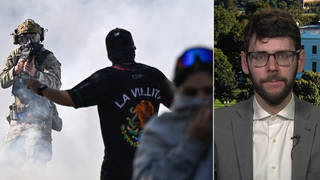
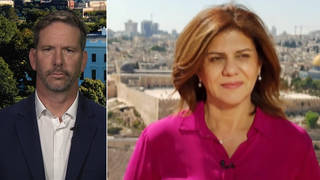
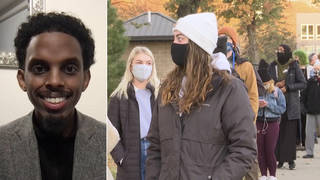
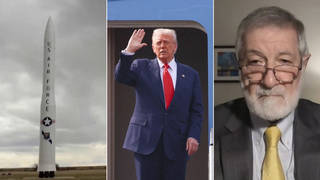





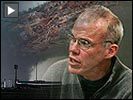

Media Options